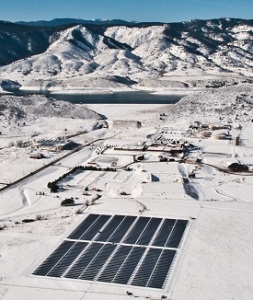CSU gets third of its power from solar panels
 Colorado State University is now supplying a third of the energy it needs to power its Foothills Campus with a field of solar photovoltaic panels.
Colorado State University is now supplying a third of the energy it needs to power its Foothills Campus with a field of solar photovoltaic panels.
In total, the 5.3-megawatt solar array will produce 8.5 million kilowatt hours every year, according to university data.
The project, which sits on 30 acres of previously unused horse pasture at the school’s mostly agricultural campus outside of Fort Collins, Colo., started as an idea four years ago, said university energy engineer Carol Dollard.
The ball got rolling when the state of Colorado passed amendment 37 in 2004, which requires utilities in the state to get a certain percentage (then 10 percent, which has since been increased to 30 percent by 2020) of their power from renewable sources and for at least a fraction of those solar arrays to be placed within the region they service.
At that time, the University was only able to get credit for 2 megawatts of solar installation, Dollard said. So a year ago in December, the University got 2 megawatts of sun-tracking solar panels installed. Shortly after construction started, the law changed and the university found out that it would be able to get credit for up to 110 percent of its energy use.
“We had the land,” Dollard said. “The University allotted 30 acres, and we only used 15. So we decided, why not develop it.”
She said she wishes they had planned the first installation better.
“My advice to people is that if one phase is possible, chances are another will be possible down the road.” Dollard said. “So plan ahead.”
The first phase of the project was perhaps more spaced out than necessary. As a result, the second phase of the project is not mounted on trackers to follow the sun. They are fixed at a 25-degree angle, Dollard said. The first phase functions at a much higher efficiency rate. But because the fixed panels don’t have to move and wont cast different shadows, they are able to sit closer together and the University was able to install more of them.
The site will be a very interesting one for students at the University and experts in the solar industry to study the differences between mounted sun-tracking solar panels and static ones, Dollard said.
Fotowatio Renewable Ventures developed, owns and operates the system on a 20-year contract, leasing the land the system sits on for $1 a year and selling the power it generates to the University at a fixed price while collecting the net-metering payments from Xcel Energy, the utility company.
The second phase of the project went online in late December and is currently producing power for the University.
“What the University gets out of it is a predictable rate for power over the next 20 years,” Dollard said. “And at the rate of increases, we expect to save millions of dollars on our utility bills over the years.”
Image courtesy of Fotowatio Renewable Ventures.



